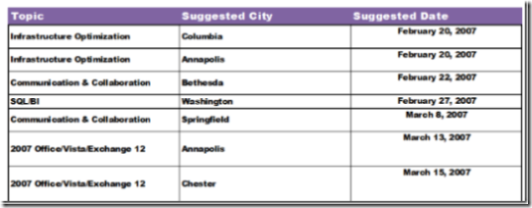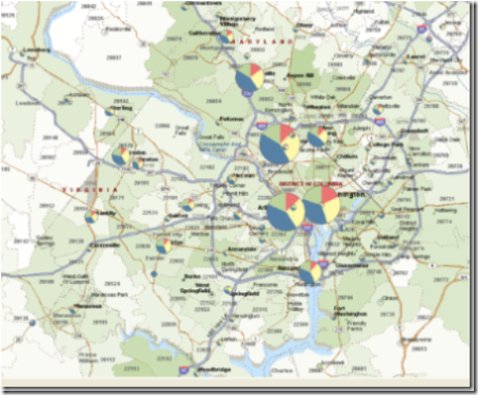Smart Placement of Partner Events...
At one time or another, you have seen a list of event slots that we are trying to fill.
These are not random allocations based on gut feel. There is data behind this to support why we are advocating (and supporting) events in these cities (dates are just to ensure that partners do not overlap with each other).
We start off with a tool called Klondike. It tell us, by customer and by product, what the upgrade opportunity may be. It's not perfect, but it helps narrow the field down. (Note: there is a further filter called a "cluster" through which we refine the types of customers, but I'll address that in another post-and link from here when I do.)
For example, if a customer purchased 10 Windows 2000 servers, but 0 Windows 2003 servers, it estimates the value of that customer in terms of potential licensing revenue.
We do this for the "big 4" products of Win2k3 server, SQL Server, Exchange Server, and Office System.
So we have the data for each of the products (and summed up) by customer (TPID means Top Parent ID).
Next step, organize it by city. In other words, for a given product, which city represents the largest upgrade opportunity? You wouldn't want to do an event for Office System in Fairfax, if there's no upgrade opportunity (say many of the customers have EA's) and you may want to do a SQL Server event in Norfolk (where's there a lot of data management surrounding the port, for example).
We also map it out using MapPoint to visually represent the data and see if there are any trends that jump out at us.
Without the data, you're sort of flying blind. We du use the 80-20 rule often to help narrow the list down, since-even though we're Microsoft, we do have limited resources. :-)
Ok, that tells us the city, but not where in the city to locate it. Some of these cities (most of them) encompass large areas.
We have found over time that customers prefer events (at least those in the morning when most of ours and our partners are) near their offices (over 70% in the case of Synergy events, for example).
So, we identify the largest opportunity by zip code within the largest city opportunities.
Now, we can help ourselves (and our partners) determine where we should locate an event for a given topic so that it is closest to the largest number of customers with whom we would like to speak.
Lastly, we allocate the slots around based on a proportional approach-for example, you'd want to have 4 times as many events in DC as you would in Gaithersburg.
Of course, there's always some human "gut feel" check, but it happens at the end, not at the beginning of the process.
Location, location, location...it still matters. And hopefully, it takes some of the guesswork out of the equation for our partners.

